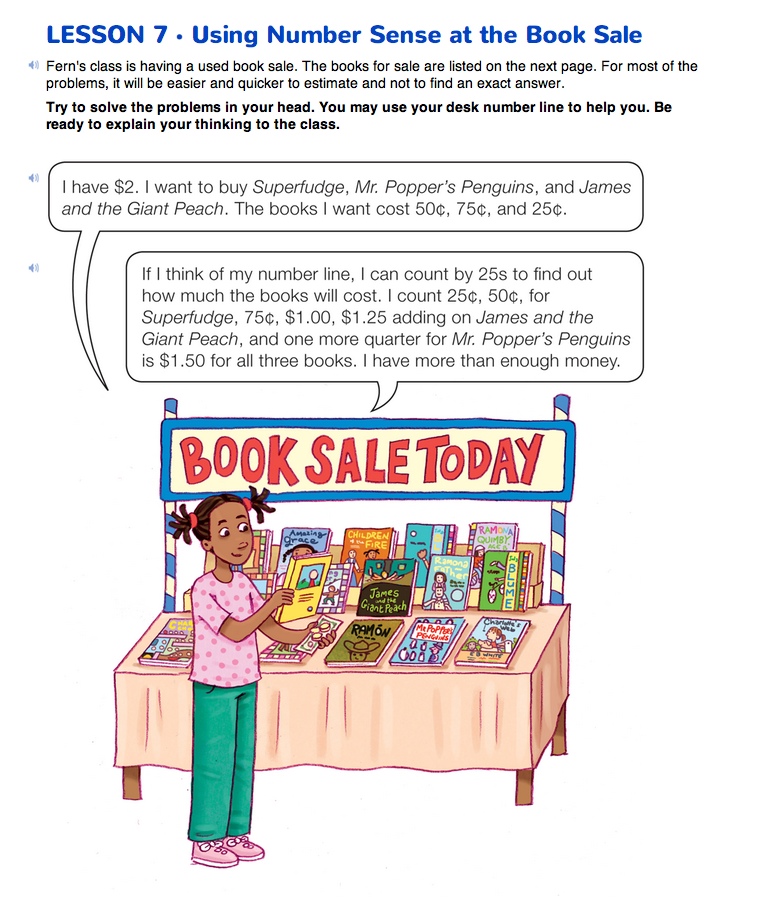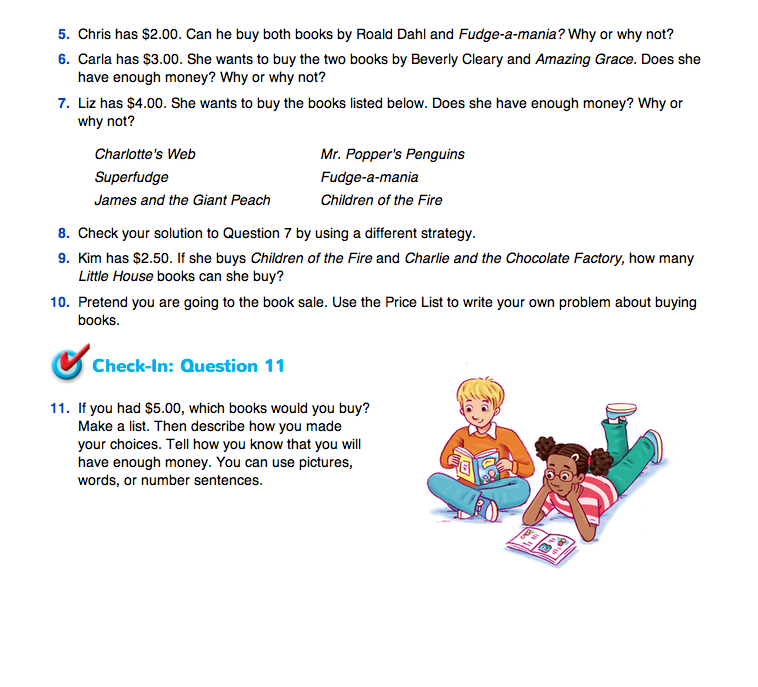Skip Count Using Benchmark Numbers. Begin the lesson by asking students to read Fern's solution to her book sale problem on the first page of the Using Number Sense at the Book Sale pages in the Student Guide.
- What strategy did Fern use to decide if she could buy all three books? (She skip counted by 25, adding the cost of each book as she went.)
- What is another way you can use benchmark numbers to check if Fern has enough money for all three books? (I know that 75¢ and 25¢ is equal to $1.00 and if I add 50¢ more that is $1.50. Since Fern has $2.00, she has enough money.)
Ask students to use the class number line to skip count by quarters (25¢, 50¢, 75¢, $1.00, $1.25). As one student points to the class number line, another student should record the numbers on a display. Continue to skip count by quarters, recording the numbers to $5.00.
Ask students to read and solve Questions 1–3.
Ask student volunteers to share their solutions to Questions 1–3 and then ask:
- Does Josh have enough money to buy the books he wanted? (Yes, he has $1.00 and the books cost less than $1.00.)
- Does Josh have just enough money or will he receive change? (He will get change.)
- Use Fern's strategy to explain how you decided on your answer? (Mr. Popper's Penguins is 25¢ and Fudge-a-mania is 50¢, so I counted by quarters to 75¢. That means Josh still has one quarter to spend. Charlotte's Web is 20¢ more. Since 20¢ is less than a quarter, I know the total will be less than $1.00.)
Ask students to read Question 4 and finish Luis's strategy for counting quarters.
Use the following prompts to discuss how Luis used this strategy:
- Does Luis have enough money to buy the books he wants? (No)
- How can you use his strategy to explain your thinking? (Luis only has $1.25. Ramon Makes a Trade is 45¢. That is almost two quarters or almost 50¢. Ramona and Her Father is 95¢, which is almost $1.00. Together they would cost almost $1.50, which is more than Luis has to spend.)
- Luis and Fern both counted quarters to see if they had enough money for their books. How was Luis's problem different from Fern's? (When Fern counted her quarters, she found an exact answer because all of her books cost one, two, or three quarters. When Luis counted quarters, he had to estimate the number of quarters that each book would cost since each of his books cost a little less than two or four quarters.)
Use Benchmark Numbers to Estimate. Assign Questions 5–10 to students. Remind them they do not need to find the exact cost of books to solve the problems. Encourage them to use the strategies they have learned to estimate the cost so they can determine if the purchase can be made. Before students begin their work ask them to review the Math Practices page in the Reference section of the Student Guide.
- What tools can you use to help you solve these problems? (Possible responses: I can use the number line to keep track when I skip count. I can draw a picture to help understand the problem. I can use money.)
- What strategies can you use to solve these problems? (Possible response: I can use benchmark numbers for money like 25¢, 50¢, or $1.00 to help me how much the books will cost.)
- How can you show or tell how you solved the problems so someone else can understand your thinking? (Possible responses: I can draw pictures to show the books that are being purchased and then draw the number of quarters that you will need for each book. I can write number sentences or show how I skip count using benchmark numbers to find the answer. I can write sentences to tell what I did for each step of the problem.)
- What labels should you use in these problems? (Possible responses: I need to tell which books are being purchased. I need to label the amount of money I am using in each problem.)















